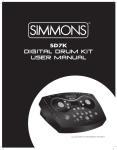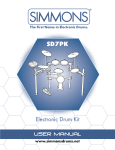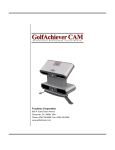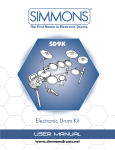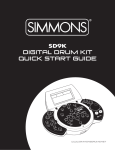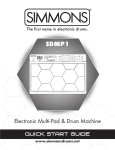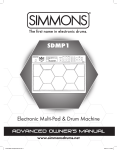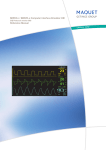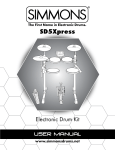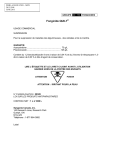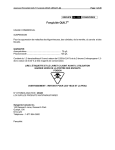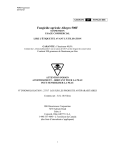Download Simmons SDHB2 User manual
Transcript
SDHB2 Hybrid electronic Add-on pack User Manual www.simmonsdrums.net FCC Statements 1. Caution: Changes or modifications to this unit not expressly approved by the party responsible for compliance could void the user’s authority to operate the equipment. 2. Note: This equipment has been tested and found to comply with the limits for a Class B digital device, pursuant to Part 15 of the FCC Rules. These limits are designed to provide reasonable protection against harmful interference in a residential installation. This equipment generates, uses, and can radiate radio frequency energy and, if not installed and used in accordance with the instructions, may cause harmful interference to radio communications. However, there is no guarantee that interference will not occur in a particular installation. If this equipment does cause harmful interference to radio or television reception, which can be determined by turning the equipment off and on, the user is encouraged to try to correct the interference by one or more of the following measures: •Reorient or relocate the receiving antenna. •Increase the separation between the equipment and receiver. •Connect the equipment into an outlet on a different circuit. •Consult an experienced radio/TV technician for help. SDHB2 Congratulations! … on your purchase of the Simmons SDHB2 Hybrid Electronic Add-On Pack. To get the most enjoyment out of this product we recommend that you read over this manual at least once, then refer back to it to learn more about specific functions. Taking Care of Your Hybrid Drum Kit Location • To avoid deformation, discoloration, or more serious damage, do not expose any part of the unit to direct sunlight, high temperature sources, or excessive humidity. Power Supply • Turn the power switch off when the SDHB2 is not in use. • The AC adapter should be unplugged from the AC outlet if the SDHB2 will not be used for an extended period of time. • Avoid plugging the AC adapter into an AC outlet that also powers high-consumption appliances such as electric heaters or televisions. Also avoid using multi-plug adapters since these can reduce sound quality, cause operation errors, and result in possible damage. • To avoid damage, turn off the SDHB2’s power switch and all related devices prior to connecting or disconnecting cables. Handling and Transport • Never apply excessive force to controls, connectors, triggers and other parts. • Unplug cables by gripping the plug firmly. Do not pull on the cable. • Disconnect all cables before moving the module. • Physical shocks caused by dropping, bumping, or placing heavy objects on the module can result in scratches and more serious damage. Cleaning • Clean the module with a dry, soft cloth. • A slightly damp cloth may be used to remove stubborn grime and dirt. • Never use cleaners such as alcohol or thinner. • To avoid discoloration, do not place vinyl objects on top of module. Electrical Interference • This module contains digital circuitry and may cause interference if placed too close to radio or television receivers. If this occurs, move the SDHB2 further away from the affected equipment. Service and Modification • There are no user serviceable parts in the drum module. • Do not attempt to open the drum module or make any change in the circuits or parts of the unit. This will void the warranty. www.simmonsdrums.net 1 Hybrid electronic add-on pack Table of Contents Assembly Panels Top Panel Rear Panel Side Panel Connections Triggers and Pads Audio Equipment Headphones MP3/CD Player Power Supply Power Switch Using the SDHB2 Triggers and Pads Playing the Triggers and Pads Metronome Kit Mode Selecting a Drum Kit Global Reverb Voice Mode Selecting the Drum Voice Adjusting Level Adjusting Pan Adjusting Tuning Saving User Kits Utility Menu Pad and Trigger Sensitivity (Gain) Crosstalk Curve Local Mode Saving Trigger Settings Restoring the Factory Preset Song Mode Selecting a Song Listening to a Song Muting the Drum Part Accompaniment Volume Drum Volume Song Source Song Tempo MIDI and USB MIDI Connection USB Connection Local Mode MIDI Channels Voice List Drum Kit List Song List General MIDI Voice List Percussion Set List MIDI Implementation Chart 2 3 5 5 6 6 7 7 8 8 8 8 8 9 9 9 10 10 10 11 11 12 12 12 12 13 13 13 14 14 14 14 15 15 15 15 16 16 16 16 17 17 17 17 17-18 19 21 21 22 23 25 SDHB2 User’s Manual SDHB2 assembly The SDHB2 Simmons Electronic Add-On Pack is a unique product that allows you to seamlessly mix your acoustic drum set with the unique electronic drum capabilities of the Simmons SD7K. This kit contains: Brain Module Stand and clamps to hold the Brain Module and pads 2 x Simmons SDPSZP Pro 9” pads 2 x 3’ and 2 x 8’ cables to connect the pads and the triggers to the Brain Module 2 x Simmons SDADT Piezo triggers Attaching the Drum Module wing screw Spread the stand’s legs and insert top of stand into base. 1. Attach the metal rod to the Drum Module. 2. Tighten the wing screw securely on the Drum Module. 3. Attach the metal rod to the holder clamp on the side arm (L1) and adjust the position. 4. Tighten the wing nut on the holder clamp. metal rod Attaching Pads to clamps The SDHB2 pads can be mounted on the clamps and attached to the enclosed stand or to any other stand on your drum set for maximum flexibility. To connect the pads, attach the pad to the L-Arm on the clamp. www.simmonsdrums.net 3 Hybrid electronic add-on pack Attaching Piezo triggers to your drums Each Piezo trigger comes with an adhesive backing that sticks to your drum head. The SDHB2 Brain is designed to trigger both the snare drum and the bass drum. Place one trigger on each drum. To attach your triggers, simply remove the protective backing of the adhesive and attach the trigger to your drum. We recommend placing the trigger approximately 1” from the rim of your snare drum and 1”–2” from the rim of your bass drum. Note: In order to optimize the response and avoid double triggering, it’s recommend that you use internal muffling in your bass drum (i.e. a pillow, blanket, or commercial muffling system). Once set, the SDADT mounting clip ensures that the audio jack stays in place. After placing your triggers on the drum head, simply remove the closest tension rod and insert it into the mount clip before re-tightening the rod. This trigger mount fastens to any tension rod. Bass Drum Trigger Snare Drum Trigger A note on terminology— Here, “Trigger” and “Pads” are used interchangeably. 4 SDHB2 User’s Manual SDHB2 Panels Top Panel 5 6 7 8 9 10 11 4 12 3 13 2 1 1 Master volume knob Controls the volume of phone and line outputs. 2 Pad select buttons and indicators In Kit mode, the buttons play the pad voices. In Voice Mode, they select the pad to be edited with indicators showing the selected pad. In Song Mode, the indicators will display which pads are being played by the drum track. 7 [SONG] button Enters or switches Song menu pages. 8 3-digit LED This LED is the main display device of the SDHB2, which will show the parameters of the current menu. 9 [VOICE] button Enters or switches Voice menu pages. 3 [TEMPO+] button, [TEMPO-] button 10 [KIT] button 4 [CLICK] button and indicator 11 [UTILITY] button Changes current tempo. Turns the metronome on or off and selects the metronome sound (click or voice). 5 [DRUM OFF] button and indicator Mutes the drum part of the song. 6 [START/STOP] button Starts and stops the selected song. www.simmonsdrums.net Enters or switches Kit menu pages. Enters or switches Utility menu pages. 12 [+] button, [-] button Changes values (kit number, voice number, song number, etc.) when editing. 13 [SAVE] button This button is used to save the current kit settings in a user kit and save the trigger settings under the Utility menu pages. 5 Hybrid electronic add-on pack Rear panel 14 Input jacks Input connections for triggers, tom, aux pads, and hi-hat control pedal. Note that Aux 1 is optimized for a Simmons Pro 9” Single Zone Pad (SDPSZP*). Aux 2* and Aux 3* are optimized for Simmons Pro 12” Cymbal Pads (SDPCMP*) The Hi-Hat input can be used with the Simmons Hi-Hat Pedal (SDHHP*) * Item sold separately 15 Line output jacks Stereo output connection to an audio system or drum amplifier such as the Simmons DA50 or DA200S. 16 AUX input jack This stereo input jack is used for an external sound source, such as an MP3 or CD player. 17 DC input 14 Connection for the DC 9V power adapter 15 16 17 side panel 18 19 Power switch Switch that turns power on and off. MIDI IN and OUT These ports allow communication with other products equipped with a MIDI interface. Please see the MIDI section of this manual for details. 20 USB port 21 Phone jack 6 A port used to connect to a computer. (MIDI In/Out via USB) A stereo jack used to connect headphones. 18 19 20 21 SDHB2 User’s Manual SDHB2 connections Triggers and Pads CAUTION! To avoid damage, turn OFF the SDHB2’s power switch and all related devices prior to connecting or disconnecting cables. Using the provided cables, connect each pad and trigger to its corresponding trigger input jack, following the marking on the cables. www.simmonsdrums.net 7 Hybrid electronic add-on pack audio equipment When using an amplifier - such as the Simmons DA50 or DA200S connect the Output L/MONO and R jacks on the rear panel to the input of the amplifier. (For mono playback, use the L/MONO jack; for stereo playback, connect both L/MONO and R jacks.) headphones An optional set of stereo headphones can be connected to the PHONES jack located on the side of the drum module. MP3/cd player 1. Connect the audio output of an MP3/CD player or other audio source to the stereo AUX IN TRS jack on the rear panel. 2. The input signal is now mixed with the drum signal, so that you can play along. power supply Connect the power adapter to the DC IN jack on the rear panel. Note: Make sure the power is switched OFF when connecting the drum module with external devices. Power Switch After confirming that all connections have been completed, rotate the volume knob to the left (its minimum volume level) before switching the power on. 8 Set the power switch to the ON position. The kit indicator will light up and the display will show kit number 001. SDHB2 User’s Manual SDHB2 using the SDHB2 Triggers and pads Playing the Triggers and pads • All the drum triggers and pads use a single trigger sensor for the whole drum or pad. • All the triggers and pads are velocity sensitive. Some voices can change sounds depending on the velocity level (striking force). metronome The SDHB2 includes a Metronome feature with two types of sounds: Click (Bell sound on the first beat, and Click sound on the other beats) or Vocal Counting (“one, two, three, four”). Press the [CLICK] button to start the metronome with the Click sound. Press the [CLICK] button a second time to change the metronome to Vocal Counting. Press the [CLICK] button again to stop the metronome. While the metronome is playing, the Beat indicator flashes at the current tempo. While the metronome is playing, the LED shows the current time signature. The time signature of the metronome can be changed using the [+] and [-] buttons. There are five available options: 2/4, 3/4, 4/4, 5/4, and 6/8. The SDHB2 returns to the previous display when the metronome is stopped. Press the [Tempo +] or [Tempo -] buttons to change the tempo (30 ~ 280). The LED shows the current tempo and returns to the previous display after about 2 seconds if there is no operation of the Tempo [+] and [-] buttons. The volume of the metronome can be adjusted by holding down the [CLICK] button and pressing the [+] or [-] buttons. The LED shows “Cxx” (xx = metronome volume: 0 ~ 16), and returns to the previous display about 2 seconds after releasing the [CLICK] button. The metronome volume resets to its default value when turning off the SDHB2. www.simmonsdrums.net 9 Hybrid electronic add-on pack kit mode If the SDHB2 is not yet in KIT Mode, press the [KIT] button to enter Kit Mode. The Kit indicator will light up. In the KIT Mode, you can select the Drum or Percussion Kit to play. You can also turn on or off the Reverb effect. Selecting a drum kit In the Kit Number page, the 3-digit LED shows the current kit number. Use the [+] and [-] buttons to select any kit (1 ~ 50, looped) as the current kit. The SDHB2 includes 20 factory preset kits (1 ~ 20) and 30 User kits (21 ~ 50). (See Kit List on page 21.) Note: In KIT mode, you can use the Pad Select buttons to play the voices associated with the pads of the currently selected kit. Global reverb When the SDHB2 is in the Kit Number page, press the [KIT] button again to access the Global Reverb page. In the Global Reverb page, the LED shows the current Reverb status (“roN” for Reverb On or “roF” for Reverb Off). Global Reverb can be turned On or Off using the [+] or [-] buttons. Press the [KIT] button again to return to the Kit Number page. 10 SDHB2 User’s Manual SDHB2 voice mode If the SDHB2 is not yet in Voice Mode, press the [VOICE] button to enter the Voice Menu. The Voice indicator will light up. Now the [VOICE] button will page through the Voice Menu. In the Voice Mode, you can select the voice for each trigger / pad and adjust the level, pan, and tuning. The current trigger or pad to be edited can be selected either by pressing its Pad Select button, or by striking the pad itself. The Pad Select indicator lights up to show which pad is currently selected. Note: While editing Voice Volume, level, pan, and tuning, you can also preview the result of the current settings by pressing the Pad Select button to play the edited voice. selecting the drum voice In the Voice Number page, the 3-digit LED shows the current voice number for the selected trigger / pad. Use the [+] and [-] buttons to select any voice (1 300, looped) for the current trigger / pad. The SDHB2 includes 300 voices sorted by category (Kick, Snare, Tom, Cymbal, Hi-Hat, Percussions). Each category includes a variety of acoustic, electric, and effects voices. (See Voice List on pages 19-20.) www.simmonsdrums.net 11 Hybrid electronic add-on pack adjusting level Press the [VOICE] button until the LED display shows “Lxx”. (xx = Level value: 0 ~ 32) Use the [+] and [-] buttons to adjust the level of the current pad. adjusting pan Press the [VOICE] button until the LED display shows “Pxx”. (xx = Pan value: -8 ~ +8) Use the [+] and [-] buttons to adjust the pan of the current pad. adjusting tuning Press the [VOICE] button until the LED display shows “txx”. (xx = Tuning value: -8 ~ +8) Use the [+] and [-] buttons to adjust the tuning of the current pad. saving user kits Make sure you save your customized kit; otherwise, your changes will be lost when you select another kit or turn off the SDHB2. Kits 001 ~ 020 are factory presets. Customized kits can be saved in User kits 021 ~ 050. User kits store all the Voice settings (Voice Number, level, pan and tuning) for all the pads. To save your customized kit to one of the User kits: 1. Press the [SAVE] button. The kit number flashes on the LED. 2. Use the [+] or [-] buttons to set the User kit number (021 ~ 050). The kit number will still be flashing. 3.Press the [SAVE] button again. The kit number stops flashing and the SDHB2 returns to Kit Mode. Note: To cancel the save operation while the LED is flashing, press the [KIT] or [VOICE] button. 12 SDHB2 User’s Manual SDHB2 Utility menu Press the [UTILITY] button to enter the Utility Mode. Now the [UTILITY] button will page through the Utility menu. In Utility Mode, you can adjust the trigger parameters (gain, crosstalk, curve) for each pad and trigger. Those parameters are common to all kits. The current trigger / pad to be adjusted can be selected either by pressing its Select button, or by striking the trigger / pad itself. The Pad Select indicator lights up to show which trigger / pad is currently selected. Pad and trigger sensitivity (gain) In the Trigger Gain page, the first digit of LED will display the letter ‘E’, followed by the gain value (1~16, not looped). Greater gain will allow you to trigger a signal, even if you strike the pad lightly. crosstalk In the Trigger Crosstalk page, the last 2 digits will show the crosstalk value (1~16) of the current pad with a letter ‘o’ displayed on the first digit of the LED. Hitting one pad may trigger the sound from another pad unintentionally. This effect can be eliminated by setting this parameter to a higher value than the mistriggered part. www.simmonsdrums.net 13 Hybrid electronic add-on pack curve In the Velocity Curve page, the curve setting allows you to control the relationship between the velocity (striking force) and loudness (the dynamic curve). The last digit will show the curve number (1~6) of the current pad with letters ‘CU’ displayed on the first two digits of the LED. local mode In local control page, the LED shows the local control mode. Local ON is the default function mode (‘LoN’). The internal link between pad triggers and sound generator will be broken when selecting Local OFF (‘LoF’). For more details regarding the Local Mode, please see the MIDI /USB section of this manual. Note: Local Control Mode always returns to Off when powering up the SDHB2. saving trigger settings After adjusting the trigger settings (gain, crosstalk, curve, splash sensitivity), you can save them into memory. While in the Utility mode, press the [SAVE] button to store all trigger settings. Note: 1. If you turn off the power without saving, you will lose the trigger setting changes you have just made. 2. These parameters affect all kits. restoring the factory preset To restore the factory preset hold down both TEMPO+ and TEMPO- when the SDHB2 is powered up. This function will replace the current settings of the following parameters by their default preset values: • All user kits (including Volume, Voice, Pan, Reverb, and Tuning setting) • Utility parameters (including gain, crosstalk, curve and splash sensitivity) 14 SDHB2 User’s Manual SDHB2 Song mode If the SDHB2 is not yet in Song Mode, press the [SONG] button to enter the Song Menu. Now the [SONG] button will page through the Song Menu. The Song indicator will light up. In the Song Mode, you can select the song number while adjusting the volume of the song’s accompaniment and drum part. In addition, you can select whether to use the internal songs or control an external sequencer. Selecting a song In Song Number page, the 3-digit LED shows the current song number. Use the [+] and [-] buttons to select any song (1 ~ 50, looped) as the current song. The SDHB2 includes 50 factory preset songs. (See Song List on page 21.) listening to a song Press the [START/STOP] button to start song playback. The Beat indicator will flash at the song tempo. After count-in, the song will start playback from the beginning. You can stop the song during playback by pressing the [START/STOP] button again. If the song number is switched while playing, the new song won’t start until the end of the current bar. During song playback in song menu, the Pad indicators will show which pads the drum track is triggering. This function can be disabled or enabled by pressing the [KICK] button while in song mode. Muting the drum part Press [DRUM OFF] to enable or disable the drum mute function. When Drum Off is enabled, the Drum Off indicator will light up, and the drum track from the current playing song will be muted. In Song mode, the Pad indicators will still show the pads played by the drum track. This allows you to practice playing the drum part along with the rest of the accompaniment. To help you play together with the song, you can also enable the metronome function by pressing the [CLICK] button. (See Metronome function for details.) www.simmonsdrums.net 15 Hybrid electronic add-on pack Accompaniment volume Press the [SONG] button until the LED display shows “Axx” (xx = accompaniment volume, 0 ~ 32). Use the [+] and [-] buttons to adjust the song’s accompaniment volume (i.e. all instruments except the drum part). The volume will be restored to default value on the next power on. drum volume Press the [SONG] button until the LED display shows “dxx” (xx = drums part volume, 0 ~ 32). Use the [+] and [-] buttons to adjust the song’s drum volume. The volume will be restored to default value on the next power on. song source In the song source selection page, the LED will show the current selected song source. There are two choices: “LoC,” for local machine (50 internal songs, default setting) or “EtN,” for controlling an external sequencer connected to the MIDI Out of the SDHB2 using MIDI Clock. See the MIDI section of the manual for details. Use the [+] and [-] to select the song source. Song playing will stop immediately when switching song source. When external sequencing is selected, press [START/STOP] to start or stop the external sequencer with corresponding MIDI real-time messages. The internal song will not playback. NOTE: If the external sequencer is selected as the current song source, the menu pages of song number, accompaniment volume, and drum volume will be not selectable. song tempo Press the [TEMPO+] or [TEMPO-] buttons to display the current tempo. Use [TEMPO+] and [TEMPO-] buttons to adjust the tempo. Press both [TEMPO+] and [TEMPO-] buttons at the same time to reset the current tempo to its default value. (This function is not available when external song is selected.) If there’s no operation, SDHB2 will return to the previous menu page automatically after 2 seconds. 16 SDHB2 User’s Manual SDHB2 MIDI and USB MIDI stands for Musical Instrument Digital Interface. This is a world-wide standard communication interface that enables electronic musical instruments and computers of all brands to communicate with each other so that instructions and other data can pass between them. This exchange of information makes it possible to create a system of MIDI instruments and devices that offer far greater versatility and control than what is available with isolated instruments. Whether you interface with computers, sequencers, expanders or other controllers, you’re sure to enhance your musical horizons. MIDI connection MIDI IN: This terminal receives MIDI data from an external MIDI device. MIDI OUT: This terminal transmits data from this instrument to other MIDI devices. usb connection The USB connector allows you to connect the SDHB2 directly to your computer. It can be connected without driver installation under the Windows XP & MAC OSX environment. The SDHB2 will be recognized as “USB Audio device” to receive and transmit MIDI messages through a single USB cable. USB is used only for MIDI messages (MIDI via USB). NOTE: When the USB is connected to a computer, all MIDI messages will be received and transmitted via USB. local mode From the MIDI’s point of view, the SDHB2 is composed of two devices: • A controller transmitting data to the pads and hi-hat control pedal (via an internal trigger to MIDI converter) • A sound generator receiving MIDI data (the sound module) In normal operation (Local ON, default mode), those two devices are connected together internally, allowing the pads to play the voices from the sound module without any external connection. When setting Local mode to Local OFF mode in the Utility menu, this internal link is disconnected. The sound module receives MIDI messages via MIDI input only, and not from the pads. However, the pad trigger data is still sent to the MIDI Output, therefore looping externally the MIDI Out of the SDHB2 back to its MIDI In will enable the pads to play the voices from the sound module. Local OFF mode is intended to be used when both the MIDI input and output (or the USB port) of the SDHB2 are connected to a MIDI sequencer with Soft Thru function (which loops the MIDI data received from the MIDI output back to the MIDI input). This prevents the doubling or flanging effect when playing the pads (caused by the sound generator receiving the same MIDI data — both directly from the pads and back through the sequencer). MIDI channels The SDHB2’s transmission channel is fixed to Channel 10 (Drums and Percussion channel). The SDHB2 will output MIDI codes generated by the triggers when hitting the pads or stepping on the Hi-Hat control pedal (Program Change, Note On/Off, and Foot Control messages). Song playback data and metronome notes are not transmitted. The MIDI system in the SDHB2 has 16 reception channels numbered from 1-16. Each channel is responsible for a voice. When the instrument receives MIDI information from an external device, the active channel is determined by the control message. Channel 10 is reserved for the Drums. Channels 9 and 16 can be used for additional Percussion sounds. (See Percussion Set list pages 23-24.) All other channels (1-8, 11-15) can be used to access the 128 General MIDI instruments and sounds included in the sound module (GM standard). These are the same instruments that are used to create the accompaniment for the internal Song player. www.simmonsdrums.net 17 Hybrid electronic add-on pack Using the SDHB2 as a general MIDI sound module Connecting an external keyboard or sequencer to the MIDI Input allows you to use the SDHB2 as a multi-timbral sound module to play various instrument parts in addition to your drums (for instance, Piano on Channel 1, Bass on Channel 2, Strings on Channel 3, etc.). The voices on each MIDI channel are selected using MIDI Program Change messages. (See the General MIDI Voice list on page 22.) NOTE: For more information on received MIDI messages, see the MIDI implementation chart. Using the SDHB2 to control a sequencer In Song mode, the song source can be set to external, allowing the SDHB2 to control the playback of an external sequencer. MIDI clock (0xF8) is sent out automatically at the current tempo, and Start and Stop Real-Time commands (0xFA, 0xFC) will be sent when pressing the Start/Stop button. 1. Connect the MIDI Out of the SDHB2 to the MIDI In of your sequencer. If you are using a software sequencer on a computer, you can simply connect the USB port of the SDHB2 to a USB port of your computer using a single USB A-B cable. 2. Setup your sequencer to respond to MIDI Clock Sync. 3. Press the Start/Stop button to start the sequence from the top. 4. Press the Start/Stop button again to stop the sequence. Note: You can adjust the tempo of your sequencer using the Tempo buttons on the SDHB2. Using a sequencer to record your SDHB2 drum performance Using the MIDI IN/OUT or USB connections with a MIDI sequencer allows you to record your performance on the SDHB2 pads and play it back with the same voices. 1. Connect the MIDI Out of the SDHB2 to the MIDI In of your sequencer, and the MIDI Out of your sequencer to the MIDI In of the SDHB2. If you are using a software sequencer on a computer, you can simply connect the USB port of the SDHB2 to a USB port of your computer using a single USB A-B cable. 2. Setup the active track of your sequencer on Channel 10. 3. Activate RECORD on your sequencer. 4. Play the pads of your SDHB2. 5. Stop recording. 6. Locate your sequencer to the start of the recording. 7. Playback the recorded sequence. 8. The SDHB2 will play the same voices that were used during recording. Notes: 1. To maintain the same voice parameters (level, pan, tuning), you should select the same Kit for playback as the Kit that was active when recording. 2. To capture and correctly reproduce the timing of your performance, make sure that the Quantize function of your sequencer is turned off. 3. If your sequencer has a Soft-Thru feature, you should set the SDHB2 to “Local Off” mode in the Utility menu. If your sequencer does not have a Soft-Thru feature, you should leave the SDHB2 in its “Local On” default mode. 18 SDHB2 User’s Manual SDHB2 Voice List # Name Acoustic Bass Drum 1 2 3 4 5 6 7 8 9 10 11 12 13 14 15 16 17 18 Standard Acoustic Kick 1 Standard Acoustic Kick 2 Rock Acoustic Kick 1 Rock Acoustic Kick 2 Jazz Acoustic Kick 1 Jazz Acoustic Kick 2 26” Large Acoustic Kick 20” Funk Acoustic Kick 20” Hip Hop Acoustic Kick 20” Tight Acoustic Kick 24” Loose Acoustic Kick 20” Small Acoustic Kick 22” 1971Kick 20” Deep Kick ‘90s Kick Metal Kick Orchestra Bass Drum Bass Drum Roll Electronic Bass Drum 19 20 21 22 23 24 25 26 27 28 29 30 31 32 33 34 35 36 37 House Kick 1 House Kick 2 House Kick 3 TR808 Kick TR909 Kick Space Kick Filter Kick Reverse Kick Techno Kick Voice Kick Low Fi Kick Junkyard Kick Disco Kick Industrial Kick Cartoon Kick Simmons Kick 1 Simmons Kick 2 Simmons Kick 3 Simmons Kick 4 # Name Acoustic Snare Drum 38 39 40 41 42 43 44 45 46 47 48 49 50 51 52 53 54 55 56 57 58 59 60 61 62 63 64 65 66 67 68 69 70 71 72 73 74 75 76 77 78 79 Snare Edge w/Rim Standard Snare Snare Cross Stick 12” Snare Rock Snare 1 Rock Snare 1 Edge Rock Snare 2 Small Room Snare Large Room Snare Jazz Snare 1 Jazz Snare Brush Edge Jazz Snare Brush Jazz Snare 2 Jazz Piccolo Snare Big Band Snare Deep Fusion Snare Effect Snare 1 Effect Snare 2 Hip Hop Snare ‘60s Snare Edge ‘60s Snare 506 Snare 506 Snare 2 506 Low Snare 506 Low Snare 2 ‘69 Snare Pong Snare Filter Snare Wood Snare 1 Wood Snare 2 Deep Maple Snare Studio Snare Distant Power Snare Crackless Snare Gunshot Snare 1 Gunshot Snare 2 Metal Snare Brush Swirl Snare Brush Strike Snare Brush Edge Snare Light Brush Snare Light Long Brush Snare www.simmonsdrums.net # Name Electronic Snare Drum 80 81 82 83 84 85 86 87 88 89 90 91 92 93 94 95 96 97 98 99 100 101 102 House Snare House Clap House Effect Snare Techno Snare Dance Beat snare Staccato Snare TR808 Snare TR909 Snare Electric Snare Reverse Snare Junkyard Snare Junkyard EFX Noise Snare Jing Snare Guak Snare Voice 1 Voice 2 Cartoon Punch Simmons Snare 1 Simmons Snare 2 Simmons Snare 3 Simmons Snare 4 Simmons Clap # Name Acoustic Tom 103 104 105 106 107 108 109 110 111 112 113 114 115 116 117 118 119 120 121 122 123 124 125 126 127 128 129 130 131 132 133 134 135 136 137 138 139 140 141 142 143 144 145 Open Tom 1 Open Tom 2 Open Tom 3 Open Tom 4 Open Tom 5 Rock Tom 1 Rock Tom 2 Rock Tom 3 Rock Tom 4 Big Tom 1 Big Tom 2 Big Tom 3 Big Tom 4 Big Tom 5 Power Tom 1 Power Tom 2 Power Tom 3 Power Tom 4 Funk Tom 1 Funk Tom 2 Funk Tom 3 Fusion Tom 1 Fusion Tom 2 Fusion Tom 3 ‘69 Tom 1 ‘69 Tom 2 ‘69 Tom 3 ‘71 Tom 1 ‘71 Tom 2 ‘71 Tom 3 Vintage Tom 1 Vintage Tom 2 Vintage Tom 3 Hip Hop Tom 1 Hip Hop Tom 2 Hip Hop Tom 3 Hip Hop Tom 4 Hip Hop Tom 5 Hip Hop Tom 6 Brush Tom 1 Brush Tom 2 Brush Tom 3 Brush Tom 4 19 Hybrid electronic add-on pack Voice List cont... # Name Electric Tom 146 147 148 149 150 151 152 153 154 155 156 157 158 159 160 161 162 163 164 165 166 167 168 169 170 171 172 173 174 175 176 177 178 179 180 181 182 183 184 185 186 187 188 189 190 191 192 193 20 TR808 Tom 1 TR808 Tom 2 TR808 Tom 3 TR808 Tom 4 TR808 Tom 5 TR808 Tom 6 Electric 1 Tom 1 Electric 1 Tom 2 Electric 1 Tom 3 Electric 1 Tom 4 Electric 2 Tom 1 Electric 2 Tom 2 Electric 2 Tom 3 Electric 2 Tom 4 Electric 3 Tom 1 Electric 3 Tom 2 Electric 3 Tom 3 TR909 Tom 1 TR909 Tom 2 TR909 Tom 3 Spike Jr Spike Look At Da Birdie Junkyard 1 Junkyard 2 Junkyard 3 Noise Tom 1 Noise Tom 2 Noise Tom 3 Voice Tom 1 Voice Tom 2 Voice Tom 3 Submarine Tom 1 Submarine Tom 2 Submarine Tom 3 Simmons V1 Tom 1 Simmons V1 Tom 2 Simmons V1 Tom 3 Simmons V2 Tom 1 Simmons V2 Tom 2 Simmons V2 Tom 3 Simmons V3 Tom 1 Simmons V3 Tom 2 Simmons V3 Tom 3 Simmons V4 Tom 1 Simmons V4 Tom 2 Simmons V4 Tom 3 Simmons Bend Tom # Name Cymbal 194 195 196 197 198 199 200 201 202 203 204 205 206 207 208 209 210 211 212 213 214 215 216 217 218 219 220 221 222 223 224 225 226 227 228 229 230 231 232 233 234 235 236 Standard 20” Ride Standard 22” Ride Standard Ride Bell Rock Ride Ride Edge Rock Bell Dry Ride Dry Ride Bell Rivet Ride Vintage Ride ‘60s Ride Clean Pop Ride Pop Ride Edge Light Flat Ride Flat Ride Junkyard Break Junkyard Metal Junkyard Spring Industrial Short Industrial Long Glass China Standard Crash China 1 Splash Crystal Crash China 2 China Low Orchestra Hit Orchestra Cymbals Gong 1 Gong 2 Water Gong Reverse Cymbal TR808 Cymbal 1 TR808 Cymbal 2 TR808 Cymbal 3 TR909 Cymbal 1 Junkyard Cymbal 1 Junkyard Cymbal 2 Cymbal Effect 1 Cymbal Effect 2 Laser Ray Drive By # Name Hi-Hat 237 238 239 240 241 242 243 244 245 246 247 248 249 250 251 252 Standard Hats 1 Standard Hats 2 Quick Hats Rock Hats Pop Hats Brush Hats ‘60’s Hats Mini Hats House Hats TR808 Hats TR909 Hats Cartoon Hats Voice Hats Junkyard Hats Noise Hats Bass Hats # Name Percussion 253 254 255 256 257 258 259 260 261 262 263 264 265 266 267 268 269 270 271 272 273 274 275 276 277 278 279 280 281 282 283 284 285 286 287 288 289 290 291 292 293 294 295 296 297 298 299 300 Metronome Bell Metronome Click Scratch Scratch Push DJ EFX HiQ Zap Ding Bell Finger Snaps Standard Clap Tambourine Vibraslap Agogo Low Agogo High Bell Tree Bongo High Bongo Low Shaker Conga Slap Low Conga Slap High Elect Conga Low Open Conga Conga Slap Cowbell Timbale Hi Timbale Low Timpani High Timpani Low Open Tabla High Open Tabla Low Slap Tabla Mute Tabla slap Cabasa Maracas Short Whistle Guiro Short Guiro Long Claves Woodblock Cuica Muted Cuica Open Triangle Muted Triangle Open Sleigh Bells Wind Chimes Castanets Surdo Muted Surdo Open Lotus Drum SDHB2 User’s Manual SDHB2 Drum Kit list # Preset Kit # Preset Kit # Preset Kit # Preset Kit Factory Preset Kits Factory Preset Kits User Programmable Kits User Programmable Kits 1 2 3 4 5 6 7 8 9 10 11 12 13 14 15 16 17 18 19 20 21 22 23 24 25 26 27 28 29 30 31 32 33 34 35 36 37 38 39 40 41 42 43 44 45 46 47 48 49 50 Rock Standard 1 Room Standard 2 Hip-hop Electronic 808 House Fusion Brush ‘60s Simmons 1 Simmons 2 Funk Jazz Latin Percussions Metal Orchestral Studio Junkyard User 1 - ‘70s User 2 - Latin Percussion User 3 - Tablas User 4 - DJ EFX User 5 - 909 User 6 - Industry User 7 - Cartoon User 8 - Voice User 9 - Simmons 3 User 10 - Simmons 4 (User 11 - Rock) (User 12 - Standard 1) (User 13 - Room) (User 14 - Standard 2) (User 15 - Hip-Hop) (User 16 - Electronic) (User 17 - 808) (User 18 - House) (User 19 - Fusion) (User 20 - Brush) (User 21 - 60s) (User 22 - Simmons 1) (User 23 - Simmons 2) (User 24 - Funk) (User 25 - Jazz Latin) (User 26 - Percussions) (User 27 - Metal) (User 28 - Orchestral) (User 29 - Studio) (User 30 - Junkyard) # Name Song List # Name 1 2 3 4 5 6 7 8 9 10 11 12 13 14 Funk 1 Fusion 1 Latin Jazz Dance Big Band Slow Fusion Samba Modern Jazz Country Reggae Salsa Bluegrass Mambo Beguine # 15 16 17 18 19 20 21 22 23 24 25 26 27 28 Name Drum ‘n Bass Jazz Bossa Pop Rock ‘n Roll 1 House Hip Hop 6/8 Ballad Ballad 1 Boogie Punk Rock ‘n Roll 2 Metal 16 Beat www.simmonsdrums.net # Name # Name 29 30 31 32 33 34 35 36 37 38 39 40 41 42 Rhumba Shuffle Swing Blues 1 Blues 2 Fusion2 Funk 2 Acid Fusion Folk Pop Latin Ballad 2 Disco 8 Beat Funk 3 43 44 45 46 47 48 49 50 Slow Rock R&B 1 R&B 2 6/8 R&B Pop Rock Hard Rock Pop Ballad New Age 21 Hybrid electronic add-on pack General MIDI voice list STRINGS 041 Violin 042 Viola 043 Cello 044 Contrabass 045 Tremolo Strings 046 Pizzicato Strings 047 Orchestral Harp 048 Timpani SYNTH PAD 089 Pad 1 (new age) 090 Pad 2 (warm) 091 Pad 3 (polysynth) 092 Pad 4 (choir) 093 Pad 5 (bowed) 094 Pad 6 (metallic) 095 Pad 7 (halo) 096 Pad 8 (sweep) CHROMATIC PERCUSSION 009 Celesta 010 Glockenspiel 011 Music box 012 Vibraphone 013 Marimba 014 Xylophone 015 Tubular Bells 016 Dulcimer ENSEMBLE 049 String Ensemble 1 050 String Ensemble 2 051 Synth Strings 1 052 Synth Strings 2 053 Choir “Aahs” 054 Voice “Oohs” 055 Synth Voice 056 Orchestra Hit SYNTH EFFECT 097 FX 1 (rain) 098 FX 2 (soundtrack) 099 FX 3 (crystal) 100 FX 4 (atmosphere) 101 FX 5 (brightness) 102 FX 6 (goblins) 103 FX 7 (echoes) 104 FX 8 (sci-fi) ORGAN 017 Drawbar Organ 018 Percussive Organ 019 Rock Organ 020 Church Organ 021 Reed Organ 022 Accordion 023 Harmonica 024 Tango Accordion BRASS 057 058 059 060 061 062 063 064 Trumpet Trombone Tuba Muted Trumpet French Horn Brass Section Synth Brass 1 Synth Brass 2 ETHNIC 105 Sitar 106 Banjo 107 Shamisen 108 Koto 109 Kalimba 110 Bagpipe 111 Fiddle 112 Shanai GUITAR 025 Acoustic Nylon Guitar 026 Acoustic Steel Guitar 027 Electric Jazz Guitar 028 Electric Clean Guitar 029 Electic Muted Guitar 030 Overdriven Guitar 031 Distortion Guitar 032 Guitar Harmonics REED 065 066 067 068 069 070 071 072 Soprano Sax Alto Sax Tenor Sax Baritone Sax Oboe English Horn Bassoon Clarinet PERCUSSIVE 113 Tinkle Bell 114 Agogo 115 Steel Drums 116 Woodblock 117 Taiko Drum 118 Melodic Tom 119 Synth Drum 120 Reverse Cymbal BASS 033 034 035 036 037 038 039 040 PIPE 073 074 075 076 077 078 079 080 Piccolo Flute Recorder Pan Flute Bottle Blow Shakuhachi Whistle Ocarina SOUND EFFECT 121 Guitar Fret Noise 122 Breath Noise 123 Seashore 124 Bird Tweet 125 Telephone Ring 126 Helicopter 127 Applause 128 Gunshot PIANO 001 002 003 004 005 006 007 008 Acoustic Grand Piano Bright Acoustic Piano Electric Grand Piano Honky-Tonk Piano Electric Piano 1 Electric Piano 2 Harpsichord Clavichord Acoustic Bass Electric Bass (finger) Electric Bass (pick) Fretless Bass Slap Bass 1 Slap Bass 2 Synth Bass 1 Synth Bass 2 SYNTH LEAD 081 Lead 1 (square) 082 Lead 2 (sawtooth) 083 Lead 3 (caliope lead) 084 Lead 4 (chiff lead) 085 Lead 5 (charang) 086 Lead 6 (voice) 087 Lead 7 (fifths) 088 Lead 8 (bass + lead) 22 SDHB2 User’s Manual SDHB2 Percussion Set list # Key Standard Room Rock Electronic Ch 10 PC Ch 9,16 PC 1 1,5 2 9 3 17,18 4 25 27 28 29 30 31 32 33 34 35 36 37 38 39 40 41 42 43 44 45 46 47 48 49 50 51 52 53 54 55 56 57 58 59 60 61 62 63 64 65 66 67 68 69 70 71 72 73 74 75 76 77 78 79 80 81 82 83 84 85 86 87 High Q Slap Scratch Push Scratch Pull Sticks Square Click Metronome Click Metronome Bell Acoustic Bass Drum Bass Drum 1 Side Stick Acoustic Snare Hand Clap Hard Snare Drum Low Floor Tom Closed Hi-Hat High Floor Tom Pedal Hi-Hat Low Tom Open Hi-Hat Low-Mid Tom Hi-Mid Tom Crash Cymbal 1 High Tom Ride Cymbal 1 Chinese Cymbal Ride Bell Tambourine Splash Cymbal Cowbell Crash Cymbal 2 Vibraslap Ride Cymbal 2 Hi Bongo Low Bongo Mute Hi Conga Open Hi Conga Low Conga High Timbale Low Timbale High Agogo Low Agogo Cabasa Maracas Short Whistle Long Whistle Short Guiro Long Guiro Claves Hi Wood Block Low Wood Block Mute Cuica Open Cuica Mute Triangle Open Triangle Shaker Jingle Bell Belltree Castanets Mute Surdo Open Surdo D D D D D D D D D D D D D D D D D D D D D D D D D#1 E 1 F 1 F#1 G 1 G#1 A 1 A#1 B 1 C 2 C#2 D 2 D#2 E 2 F 2 F#2 G 2 G#2 A 2 A#2 B 2 C 3 C#3 D 3 D#3 E 3 F 3 F#3 G 3 G#3 A 3 A#3 B 3 C 4 C#4 D 4 D#4 E 4 F 4 F#4 G 4 G#4 A 4 A#4 B 4 C 5 C#5 D 5 D#5 E 5 F 5 F#5 G 5 G#5 A 5 A#5 B 5 C 6 C#6 D 6 D#6 www.simmonsdrums.net Bass Drum 2 Rock Kick Drum D Snare Drum 2 D Hard Snare Drum Room Low Tom 2 Closed Hi-Hat 2 Room Low Tom 1 Pedal Hi-Hat 2 Room Mid Tom 2 Open Hi-Hat 2 Room Mid Tom 1 Room Hi Tom 2 D Room Hi Tom 1 Ride Cymbal 2 Chinese Cymbal 2 Ride Bell 2 D Splash Cymbal 2 Cowbell 2 D D D D D D D D D D D D D D D D D D D D D D D D D D D D D D D Acoustic Bass Drum 2 Rock Kick Drum D Acoustic Snare 2 D Acoustic Snare 3 Rock Low Tom 2 Closed Hi-Hat 2 Rock Low Tom 1 Pedal Hi-Hat 2 Rock Mid Tom 2 Open Hi-Hat 2 Rock Mid Tom 1 Rock Hi Tom 2 D Rock Hi Tom 1 Ride Cymbal 2 Chinese Cymbal 2 Ride Bell 2 D Splash Cymbal 2 Cowbell 2 D D D D D D D D D D D D D D D D D D D D D D D D D D D D D D D Acoustic Bass Drum El Kick Drum D Hard Snare Drum D Electric Snare El Low Tom 2 Closed Hi-Hat 3 El Low Tom 1 Pedal Hi-Hat 3 El Mid Tom 2 Open Hi-Hat 3 El Mid Tom 1 El Hi Tom 2 D El Hi Tom 1 D D D D D D D D D D D D D D D D D D D D D D D D D D D D D D D D D D D D D 23 Hybrid electronic add-on pack Percussion Set list cont... # 808 Jazz Brush Orchestra Effects Ch 10 PC Ch 9,16 PC 5 26 6 33 7 41 8 49 N/A 57 27 28 29 30 31 32 33 34 35 36 37 38 39 40 41 42 43 44 45 46 47 48 49 50 51 52 53 54 55 56 57 58 59 60 61 62 63 64 65 66 67 68 69 70 71 72 73 74 75 76 77 78 79 80 81 82 83 84 85 86 87 D D D D D D D D D D D D D D D D D D D D D D D D Closed Hi-Hat 2 Pedal Hi-Hat Open Hi-Hat 2 Ride Cymbal 1 D D D D Concert BD 2 Concert BD 1 D Concert SD Castanets Concert SD Timpani F Timpani F# Timpani G Timpani G# Timpani A Timpani A# Timpani B Timpani C Timpani C# Timpani D Timpani D# Timpani E Timpani F D D D Concert Cymbal 2 D Concert Cymbal 1 D D D D D D D D D D D D D D D D D D D D D D D D D D D D Buzz Gong Scratch FX1 Scratch FX2 Scratch FX3 Scratch FX4 Gtr.Cut Noise Gtr.Cut Noise 2 (up) Muted Dist.Gtr. 1 Muted Dist.Gtr. 2 Dist.Gtr. Slide 1 Dist.Gtr. Slide 2 High Q Slap Scratch Push Scratch Pull Sticks Square Click Metronome Click Metronome Bell Guitar Slide Gtr.Cut Noise1(down) Gtr.Cut Noise 2 (up) Gtr.Cut Noise 3 Key Click Laugh Scream Punch Heart Beat Footstep1 Footstep2 Applause Door Creak Door Slam Scratch Wind Chine Car Engine start Car Break Car Pass By Gun Shot Crickets Train Noise Helicopter Industrial Noise Gun Shot Machine Gun Laser Gun Explosion Dog Bark Horse Gallop Birds Chirping Rain Thunder Wind Sea Shore Stream Bubbles Cat Bird Dog 24 Key D#1 E 1 F 1 F#1 G 1 G#1 A 1 A#1 B 1 C 2 C#2 D 2 D#2 E 2 F 2 F#2 G 2 G#2 A 2 A#2 B 2 C 3 C#3 D 3 D#3 E 3 F 3 F#3 G 3 G#3 A 3 A#3 B 3 C 4 C#4 D 4 D#4 E 4 F 4 F#4 G 4 G#4 A 4 A#4 B 4 C 5 C#5 D 5 D#5 E 5 F 5 F#5 G 5 G#5 A 5 A#5 B 5 C 6 C#6 D 6 D#6 Acoustic Bass Drum 2 808 Kick Drum D 808 Snare Drum D Hard Snare Drum 808 Low Tom 2 808 Closed Hi-Hat 808 Low Tom 1 808 Pedal Hi-Hat 808 Mid Tom 2 808 Open Hi-Hat 808 Mid Tom 1 808 Hi Tom 2 808 Cymbal 808 Hi Tom 1 D D D D D D D D D D D 808 Mute Hi Conga 808 Open Hi Conga 808 Low Conga D D D D D 808 Maracas D D D D 808 Claves D D D D D D D D D D D D Jazz Kick 2 Jazz Kick 1 D Jazz Snare Drum D Hard Snare Drum Jazz Low Tom 2 Closed Hi-Hat 2 Jazz Low Tom 1 Pedal Hi-Hat 2 Jazz Mid Tom 2 Open Hi-Hat 2 Jazz Mid Tom 1 Jazz Hi Tom 2 D Jazz Tom 1 D D D D Splash Cymbal 3 D D D D D D D D D D D D D D D D D D D D D D D D D D D D D D D D Jazz Kick 2 Jazz Kick 1 D Jazz Snare Drum Hand Clap Brush Slap Brush Low Tom 2 D Brush Low Tom 1 D Brush Mid Tom 2 D Brush Mid Tom 1 Brush Hi Tom 2 D Brush Hi Tom 1 D D Rivet Ride D Splash Cymbal 3 D D D D D D D D D D D D D D D D D D D D D D D D D D D D D D D D SDHB2 User’s Manual SDHB2 midi implementation chart Function Basic Default Channel Changed Default Mode Messages Altered Note Number: True voice Velocity Note on Note off After Key’s Touch Channel’s Pitch Bend Control 0 Change 1 4 5 6 7 10 11 64 65 66 67 80 81 91 93 100, 101 120 121 123 Program Change System Exclusive System : Song Position Common : Song Select : Tune System : Clock Real Time : Commands Aux : Local ON/OFF : All Notes OFF Messages : Active Sense : Reset Transmitted Recognized 10 ch X X X ************** 0–127 ************** 0 (99H, V=1–127) 0 (99H,V=0) X X X X X 0 X X X X X X X X X X X X X X X X X 0 X X X X 0 0 X X 0 X 1–16 X X X ************** 0–127 0–127 0 (9nH,V=1-127) 0 (8nH or 9nH,V=0) X X 0 0 0 0 0 0 0 0 0 0 0 0 0 0 0 0 0 0 0 0 0 0 0 X X X X X X X X X 0: YES X: NO www.simmonsdrums.net Remarks Bank Select Modulation Foot Controller Portamento Time Data Entry Volume Pan Expression Sustain Pedal Portamento ON/OFF Sostenuto Pedal Soft Pedal Reverb Program Chorus Program Reverb Level Chorus Level RPN LSB, MSB* All Sound OFF Reset All Controller All Notes OFF START and STOP only * Valid RPN # 0,1,2 25 One (1) Year Limited Warranty Subject to the limitations set forth below, Simmons® hereby represents and warrants that the components of this product shall be free from defects in workmanship and materials, including implied warranties of merchantability or fitness for a particular purpose, subject to normal use and service, for one (1) year to the original owner from the date of purchase. Retailer and manufacturer shall not be liable for damages based upon inconvenience, loss of use of product, loss of time, interrupted operation or commercial loss or any other incidental or consequential damages including but not limited to lost profits, downtime, goodwill, damage to or replacement of equipment and property, and any costs of recovering, reprogramming, or reproducing any program or data stored in equipment that is used with Simmons® products. This guarantee gives you specific legal rights. You may have other legal rights which vary from state to state. Some states do not allow limitations on how long an implied warranty lasts, so the above limitation may not apply to you. Simmons P.O. Box 5111 Thousand Oaks, CA 91359-5111 All trademarks and registered trademarks mentioned herein are recognized as the property of their respective holders. Made in China 0809-8288 www.simmonsdrums.net




























